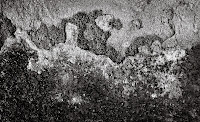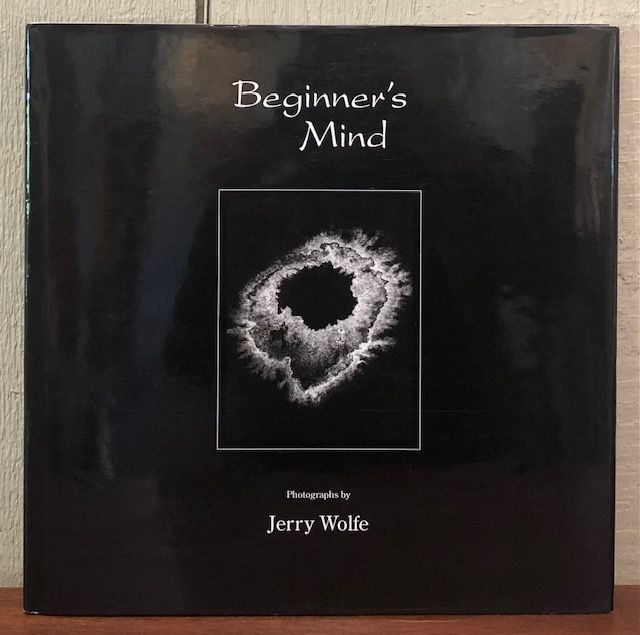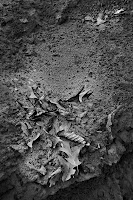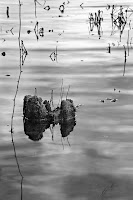 A few years ago, I gave an invited presentation at the Smithsonian Institute in Washington, DC, entitled Nature's Way: The Art of Seeing Complexity. My lecture was part of a multiweek workshop sponsored jointly by the Washington Center for Complexity & Public Policy and the Resident Associate Program of the Smithsonian Institution.
A few years ago, I gave an invited presentation at the Smithsonian Institute in Washington, DC, entitled Nature's Way: The Art of Seeing Complexity. My lecture was part of a multiweek workshop sponsored jointly by the Washington Center for Complexity & Public Policy and the Resident Associate Program of the Smithsonian Institution.
The ambitious goal I set out to accomplish with my talk - which, in hindsight I ought to have known would be impossible to achieve in the short time I had to achieve it (about two hours) - was to use the soul-searching inner musings of a physicist as photographer as a springboard toward forging a possible conceptual bridge between art and science; one that is defined by an aesthetic grammar, and hints at an even deeper aesthetic physics (two phrases that I promise to define more carefully below). As I diligently plowed through my slides, and talked through a few I had prepared especially to explain these subtle points, I could tell from the many blank stares and questioning smirks, that my skeletal new art-science "aesthetics theory" was destined to fall far short of my intended goal that day.
"The division of the perceived universe into parts and wholes is convenient and may be necessary, but no necessity determines how it shall be done." - Gregory Bateson (anthropologist, 1904 - 1980)
So, for another, slightly expanded attempt at communicating some soul-searching inner musings of a physicist as photographer...let me begin - in Part I of a multipart series of essays I intend posting in the coming weeks on the same topic as my Smithsonian talk, but retitled Towards an Aesthetic Grammar - by introducing a provocative theorem that I will first make a cautionary meta-claim about: please be forewarned that the theorem I am about to state will likely strike you either as obvious (at best) or idiotically vacuous (at worst). However, I will immediately argue that not only does the truth (of its interpretation) lie nowhere near these two extremes, but that the theorem is deceptively subtle and points to a universal "core truth" that underlies all cognitive, scientific and creative endeavors!
What is this remarkable theorem? It is called the "Ugly-Duck Theorem" (named after the well-known
story by
Hans Christian Andersen), and was proposed and proven by statistician Satosi Watanabe in 1969 (who was then at the University of Hawaii).
Suppose that the number of predicates that are simultaneously satisfied by two nonidentical objects of a system, A and B, is a fixed constant, P. The Ugly Duck theorem asserts that the number of predicates that are simultaneously satisfied by neither A nor B and the number of predicates that are satisfied by A but not by B are both also equal to P. While this assertion is easy to prove, and certainly appears innocuous at first glance - indeed, you would be forgiven to think it entirely "meaningless" since it is merely restating an obvious combinatorial fact about the set of possible predicates - it has rather significant philosophical and conceptual consequences.
"Thought is creating divisions out of itself and then saying that they are there naturally." - David Bohm
For example, suppose that there are only three objects in the world, arbitrarily labeled (@,@,#). An obvious interpretation is that this describes two kinds of objects: two @s and one #. But there are other ways of partitioning this set. For example, line them up explicitly this way: @ @ #. An implicit new organizing property seems to emerge: the leftmost @ and the rightmost # share the property that they are "not in the middle". We are free to label this property using the symbol @, and the property of being in the middle, #. Now, substituting the new property for each of the original objects, we have @ @ # -> @ # @.
Had we sorted these three objects according to the new property (that discriminates according to spatial position), we would again have two kinds of objects, but in this case they would have been different ones. Obviously, we can play this game repeatedly, since there are endless number of possible properties that can arbitrarily be called @ and #. That is the point. Unless there is an objective measure by which one set of properties can be distinguished from any of the others, there is no objective way to assert that any subset of objects is better than, or different from, any other.
The theorem demonstrates that there is no a priori objective way to ascribe a measure of similarity (or dissimilarity) between any two randomly chosen subsets of a given set. (Or, stated more whimsically, the theorem states that, all things being equal, an ugly duck is just as similar to a swan as two swans are to each other!) More technically speaking, we see that asymmetries within a system (i.e., differences) can be induced only either via some externally imposed “aesthetic” measure, or generated from within.

"Of course" ... you might be saying ... "that is obvious! But why is this important?" It is important because it demonstrates that - fundamentally - all of our perceptions of the world, precisely because they are demonstrably not all uniform, appear as sets of different things interrelated in a myriad of ways because of an internal aesthetic (or internal grammar, or physics!) that we automatically impose on what we perceive (doing so mostly unconsciously). The problem is to find a way to characterize and articulate what such a grammar might actually look like!
We "see" rocks and chairs and people primarily because nature has evolved an immeasurably powerful sensory-cognitive processing mechanism that rapidly "tags" for us (for our "I") the patterns in our environment that we will most likely be interacting with repeatedly throughout our lifetime. These objects are not visible to us (as "things") because the universe has labeled them "objectively meaningful" in a global sense (I doubt whether the universe really cares whether a particular transient pattern of atoms is called a "chair", a "collection of wooden planks" or "an exemplar of post-modern, neo-minimalist drivel"); rather, they appear to us as "meaningful" only because they are meaningful to us locally, in terms of the natural aesthetics we were born with (and evolve for ourselves as we interact with our perceptions and experiences) that determine what objects we can see, and the degree to which we can distinguish one object from another.
Who we are - our "I" - is defined and shaped most strongly by our internal aesthetic; which, I shall argue shortly, does not just describe "what we happen to think is beautiful at the moment" but molds our entire conception of the world, with all of the artistic, scientific, philosophical and spiritual depths that entails.
When I use the phrase "conceptual grammar" (or "aesthetic grammar") I mean - no more and no less - the set of aesthetic-weights we use (mostly unconsciously) to ascribe more or less "thingness" to an object A compared to another object B. According to the Ugly Duck theorem, we would expect the components of this set of weights to all be equal and therefore completely undiscerning in a rigorously objective world. Our conceptual grammar, understood in this way, therefore also constitutes the backbone of a primitive "local physics" we all use to describe our world; where by "physics" I mean a set of "organizing principles" that describe the underlying patterns of what our aesthetics "permit" us to recognize as existing.
Thus, when I write "grammar", I am thinking of primitive building blocks of "things" that (we imagine and/or perceive to) populate our (aesthetically generated asymmetric) local world, and the ways in which things may be "combined" to yield other things. And when I write "physics", I am thinking of the primitive building blocks of "patterns" that connect the things.
"Man tries to make for himself in the fashion that suits him best a simplified and intelligent picture of the world; he then tries to some extent to substitute this cosmos of his for the world of experiences, and thus to overcome it. This is what the painter, the poet, the speculative philosopher, and the natural scientist do, each in his own fashion." - Albert Einstein
I will discuss some important consequences of the Ugly Duck theorem, and suggest how it might be used to generalize what we (think we) know about our "scientific aesthetics" to begin probing what an (objectively artful) "aesthetic grammar" may look like, in Part II (stay tuned....) Speculations on what all of this has to do with complexity, photography, the "art of seeing", and using art to find one's "I", will also appear in forthcoming essays.
Technical Note: The
Ugly Duck Theorem complements another well-known theorem called the
No Free Lunch theorem, proven by Wolpert and Macready in 1996. The
No Free Lunch theorem asserts that the performance of all search algorithms, when averaged over all possible cost functions (i.e., problems), is exactly the same. In other words, no search algorithm is better, or worse, on average than blind guessing. Algorithms must be tailored to specific problems, which therefore effectively serve as the
external aesthetic by which certain algorithms are identified as being better than others. Technical proofs of Watanabe's theorem appear in his books
Knowing and Guessing and
Pattern Recognition (both of which are, sadly, out of print).
 One of the special joys of photography is to discover something transcendent in what "objectively speaking" is completely ordinary; and use the medium to share your vision with others. A case in point, is a simple, humble, little tree, that I always see just outside the first level of the garage I use to park my car for work, and as I make the first turn to find a spot to park. I see a bit less of it as I continue downward to the second level, and it disappears from view completely as I weave my way to the third, and final level. I almost always choose to walk up to the entrance of my building using the outside stairs, rather than take the elevator directly from the ground level, because I want to enjoy "seeing" this little tree for a few extra seconds before beginning my work day. It has thus been a quiet companion of mine for years; and always puts a smile on my face as I embark on my workday, readying myself mentally to be immersed in my usual sea of equations and computer code.
I call it a humble tree, because that is how it appears to me. Its small and unassuming form is overshadowed by the thick trunks and dense foliage surrounding it. It is practically invisible, standing as it does just outside the garage, effectively lost among the scattered walkways, outside furniture and nearby construction. Sadly, it also does not appear to be doing particularly well physically this year, as its already lost most of its leaves, and very few achieved their usual rich autumn colors before falling. But there it stands, with its graceful arcs and branches serving as a subtle aesthetic ground to everything surrounding it. I silently lament how so few people ever seem to notice its delicate beauty. Though my coworkers frequently jog for exercise up and down the inclined hill on which it grows, few, if any, ever glance in its direction.
I resolved to show others what this serene sentinel has generously provided me for so long. I waited for a nice day (which, in photographer's speak, means an overcast, moist day;-), started my commute to work a few minutes early to buy myself some extra time, set up my tripod on the first level and took a few exposures. Some friends passed by in their cars. Most smiled quizzically, and squinted from their seats to try to make out the source of my fascination. One, a fellow photographer, stopped by to take a closer look, and nodded appreciatively. Another, not a photographer, also stopped by and was visibly perplexed that this "unassuming tree" was really the subject of my focus. "I'll show you what I see later, when I've had a chance to express it," I said. "OK," he replied, "but its just a little tree, and not a terribly interesting one at that," and walked away.
What my friend probably saw, was what my camera faithfully rendered with its CMOS circuitry, reproduced below...
One of the special joys of photography is to discover something transcendent in what "objectively speaking" is completely ordinary; and use the medium to share your vision with others. A case in point, is a simple, humble, little tree, that I always see just outside the first level of the garage I use to park my car for work, and as I make the first turn to find a spot to park. I see a bit less of it as I continue downward to the second level, and it disappears from view completely as I weave my way to the third, and final level. I almost always choose to walk up to the entrance of my building using the outside stairs, rather than take the elevator directly from the ground level, because I want to enjoy "seeing" this little tree for a few extra seconds before beginning my work day. It has thus been a quiet companion of mine for years; and always puts a smile on my face as I embark on my workday, readying myself mentally to be immersed in my usual sea of equations and computer code.
I call it a humble tree, because that is how it appears to me. Its small and unassuming form is overshadowed by the thick trunks and dense foliage surrounding it. It is practically invisible, standing as it does just outside the garage, effectively lost among the scattered walkways, outside furniture and nearby construction. Sadly, it also does not appear to be doing particularly well physically this year, as its already lost most of its leaves, and very few achieved their usual rich autumn colors before falling. But there it stands, with its graceful arcs and branches serving as a subtle aesthetic ground to everything surrounding it. I silently lament how so few people ever seem to notice its delicate beauty. Though my coworkers frequently jog for exercise up and down the inclined hill on which it grows, few, if any, ever glance in its direction.
I resolved to show others what this serene sentinel has generously provided me for so long. I waited for a nice day (which, in photographer's speak, means an overcast, moist day;-), started my commute to work a few minutes early to buy myself some extra time, set up my tripod on the first level and took a few exposures. Some friends passed by in their cars. Most smiled quizzically, and squinted from their seats to try to make out the source of my fascination. One, a fellow photographer, stopped by to take a closer look, and nodded appreciatively. Another, not a photographer, also stopped by and was visibly perplexed that this "unassuming tree" was really the subject of my focus. "I'll show you what I see later, when I've had a chance to express it," I said. "OK," he replied, "but its just a little tree, and not a terribly interesting one at that," and walked away.
What my friend probably saw, was what my camera faithfully rendered with its CMOS circuitry, reproduced below...
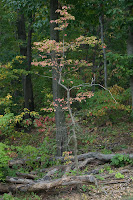 What I saw, and what I almost always see when I pass by my humble little friend, is the image that is reproduced at the top of this blog entry. The tree seems to be both bathed in and to emanate a soothing, ethereal glow; as though its roots are not just joined to the earth but stretch into something beyond as well. The mildly duotoned black and white conversion conveys something of what I see when I look at this tree; and it is not at all obvious from the "straight" color image.
I admit to it being a very pure joy for me, as a photographer, to not only be able to "see" this tree in its more resplendently luminous form - to see its very soul, so to speak - but to be able to express (at least some semblance of) what I feel while communing with it. The tree thus now rewards me twice each day. Once, as it continues to paint a smile on my face when it greets me in the morning; and a second time, whenever someone comes into my office, notices the print I made of my luminous companion hanging on my wall, and says (usually, with some incredulity!), "That's not that little tree you were talking about, is it? Wow! Never thought much of it before. It's beautiful!"
As others have observed, one does not have to travel to exotic far-away places to find beauty.
What I saw, and what I almost always see when I pass by my humble little friend, is the image that is reproduced at the top of this blog entry. The tree seems to be both bathed in and to emanate a soothing, ethereal glow; as though its roots are not just joined to the earth but stretch into something beyond as well. The mildly duotoned black and white conversion conveys something of what I see when I look at this tree; and it is not at all obvious from the "straight" color image.
I admit to it being a very pure joy for me, as a photographer, to not only be able to "see" this tree in its more resplendently luminous form - to see its very soul, so to speak - but to be able to express (at least some semblance of) what I feel while communing with it. The tree thus now rewards me twice each day. Once, as it continues to paint a smile on my face when it greets me in the morning; and a second time, whenever someone comes into my office, notices the print I made of my luminous companion hanging on my wall, and says (usually, with some incredulity!), "That's not that little tree you were talking about, is it? Wow! Never thought much of it before. It's beautiful!"
As others have observed, one does not have to travel to exotic far-away places to find beauty.









